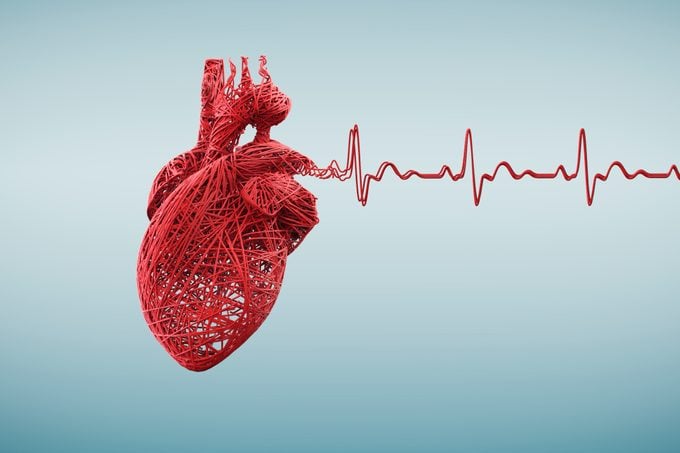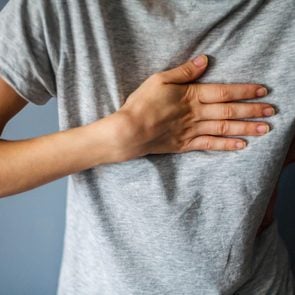What to Know About Sinus Arrhythmias, a Type of Irregular Heartbeat
Updated: Mar. 11, 2022
A sinus arrhythmia—an irregular heartbeat—is often nothing to worry about, but here's when it may be a sign of something more serious.
What is a sinus arrhythmia?
Despite its name, a sinus arrhythmia has nothing to do with a common sinus infection. It is a disorder of the heart rate or heart rhythm.
A sinus arrhythmia (a medical term for an irregular heartbeat) means that the heart beats too fast or too slow, or irregularly.
Most often a sinus arrhythmia is temporary and nothing to worry about—like the accelerated heartbeat you feel when you had an extra shot of espresso—or slower heartbeat when you’re sleeping.
Other times an arrhythmia could point to an underlying condition. And although it’s rare, a sinus arrhythmia could become an urgent medical matter. (Here’s how one nurse diagnosed her own heart arrhythmia.)
Here’s what you should know about sinus arrhythmias and how they might affect your heart.
What’s a normal sinus rhythm?
By definition, a normal sinus rhythm is a regular heart beat, with a heart rate that ranges from 60 to 100 beats/minute.
“Regular means that the distance between each heartbeat is the same, much like a sound of a metronome,” says Lee Goldberg, MD, a cardiologist and section chief, advanced heart failure and cardiac transplant at the University of Pennsylvania, in Philadelphia.
“Sinus arrhythmia occurs when there is a minor variation of more than 0.12 seconds between heartbeats. This makes the heart rhythm irregular but only mildly so,” says Dr. Goldberg, who is also a professor of cardiovascular medicine in the Perelman School of Medicine at the University of Pennsylvania. “Sinus arrhythmia is considered a variant of normal sinus rhythm.”
(This is what it means when your heart skips a beat.)

How electrical signals affect arrhythmias
To understand how and why arrhythmias occur, we have to take a peek at the intricate workings of the heart. The heart has two systems—pumping and electrical—that work together to move blood throughout the body.
In the pumping function, the four chambers (left atrium, left ventricle, right atrium, and right ventricle) of the heart move blood in specific directions with the help of valves that prevent backflow. The “lub-dub” of a heartbeat is the sound of the heart valves closing after the atria contract, followed by the closure of other heart valves after the ventricles contract.
This coordinated contraction is controlled by electrical signals that keep the heart pumping blood to the lungs and the body. The signals come from an electrical system that is wired throughout the heart, and problems with this system can cause an arrhythmia.
“This system enables the top chambers (left and right atria) to contract first, filling the bottom chambers (right and left ventricles). Once they are full, the ventricles contract and eject blood in the lungs or the rest of the body,” Dr. Goldberg says.
The process involves two switches. The first switch is called the sinoatrial or SA node, which generates an electrical signal. The SA node is a cluster of cells that acts as the natural pacemaker for the heart.
“Once the electrical impulse leaves the SA node, it heads to the atria, causing it to contract from the top down, pushing the blood in the atria through the valves and into the ventricles,” Dr. Goldberg says.
The second switch is the atrial ventricular or AV node, which acts like a secondary pacemaker. It delays the electrical impulses for a short time, then quickly releases them to the ventricles, which contract from the bottom up.
“This zipper-like action causes blood to be ejected with significant force out of the heart and to the lungs or the body,” says Dr. Goldberg. Like the SA node, the VA node has connections to the nervous systems and can detect and respond to chemicals in the blood, impacting heart rate.
Types of sinus arrhythmias
Sinus arrhythmias are typically short-lived and rarely need any treatment. In some cases, arrhythmias may be more troublesome and cause more symptoms. In those cases, they are treated and managed with medications or procedures.
There are three types of sinus arrhythmias.
Tachycardia: a fast heartbeat with a resting heartbeat of more than 100 beats per minute
Bradycardia: a slow heartbeat with a resting heartbeat of 60 beats or less per minute. Interestingly, athletes may have a heart rate below 60 beats per minute, as intense cardio training can make the heart more efficient.
Premature heartbeat: an extra heartbeat that occurs earlier than expected. It’s commonly described as a “thump” or a skipped heartbeat.
Symptoms of sinus arrhythmias
You might not feel an arrhythmia at all. Or, you might feel like your heart skipped a beat or is fluttering, or feel like you’re going to faint. Symptoms can also be less specific such as lightheadedness, unexplained fatigue, or shortness of breath.
Patients with no symptoms are often found to have arrhythmias during a routine physical exam, or sometimes during a preoperative evaluation for another procedure, says Rakesh Latchamsetty, MD, an assistant professor and electrophysiologist cardiologist (a cardiologist who specializes in heart rhythm problems) at the Michigan Medicine Frankel Cardiovascular Center, in Ann Arbor.
When you notice symptoms are happening more often, start tracking them. Note when the arrhythmia occurred and what you were doing at the time. It will help your doctor to diagnose and treat the arrhythmia. More serious symptoms include:
- Chest pain
- Difficulty breathing
- Feeling faint or fainting
- Foggy thinking
- Anxiety
- Blurred vision
- Feeling extremely tired or weak
- Feeling dizzy or lightheaded
- Sweating
If you are experiencing symptoms of a heart attack, don’t waste time. Seek medical attention immediately.
Causes of sinus arrhythmias
Arrhythmias occur when there is a slight variation in between heartbeats. Variants happen when something triggers it (caffeine, cough medicine, sudden stress, or many other things), causing a snag in the electrical system resulting in an abnormal signal.
Those signals could slow down, block, or travel a different route through the heart. The arrhythmia could continue if there are other problems in the heart. Some common triggers are:
- Electrolyte imbalance from abnormal levels of potassium, magnesium, sodium, and other substances in the body
- Certain over-the-counter medicines, such as cough, cold, and allergy medication, and appetite suppressants
- Caffeine
- Sudden stress, anger, or surprise
- Vomiting and coughing
- Pain
- Some prescription medications used to treat high blood pressure, depression, or other conditions.
Risk factors that may increase sinus arrhythmias
Numerous factors may increase your chance of having an arrhythmia. Here are some of the most common conditions and lifestyle choices that can increase the risk of developing an arrhythmia:
- Coronary artery disease
- Leaky or narrow heart valves
- Covid-19
- High blood pressure
- Diabetes
- Low blood sugar
- Kidney disease
- Lung disease
- Smoking nicotine cigarettes
- High cholesterol levels
- Being overweight or obese
- Regularly eating a high-fat diet
- Bulimia and anorexia
- Drinking too much alcohol
- Using drugs such as cocaine or amphetamines
- Unmanaged stress
- Sleep apnea
- Sepsis
- Family history of heart disease or arrhythmia
- Advancing age
Diagnosing a sinus arrhythmia
In most cases sinus arrhythmias come and go with little to no noticeable symptoms, so there isn’t any cause for alarm. But if symptoms become more frequent and noticeable or get worse, it’s time for further medical evaluation.
“The location in the heart from where the arrhythmia generates, the specific behavior of the arrhythmia, and any associated cardiac conditions help determine how serious the arrhythmia is and what additional testing is required,” Dr. Latchamsetty.
A full medical history, including any family history of arrhythmia, blood tests, and that diary of symptoms and activities all help your doctor diagnose arrhythmias.
Standard tests for sinus arrhythmias might include the following:
- Electrocardiogram (ECG or EKG)
- Chest X-ray
- Exercise stress test
- Tilt table test, which changes your position rapidly from vertical to horizontal to see if your blood pressure changes of if you faint
- Echocardiogram or transesophageal echocardiogram
- Electrophysiologic testing
- MRI of the heart
- Holter and event monitors—a portable ECG that records heart activity for 24 hours or more
Treatments for sinus arrhythmia
There’s a good chance you won’t need treatment. “Many arrhythmias are benign and only need to be treated based on the symptoms they cause while others have the potential to cause harm,” says Dr. Latchamsetty.
Arrhythmias that cause significant symptoms or complications, or a more severe arrhythmia, may be treated with anti-arrhythmic medications to restore normal heart rhythm or control heart rate and/or blood thinners to mitigate blood clots.
If medications aren’t working, a pacemaker or implantable cardioverter-defibrillator (ICD) may help. In these cases, a device is implanted in your body to deliver electrical signals that correct the irregular heartbeat or in the case of an ICD, deliver a shock to correct a potentially life-threatening heart rhythm.
Your doctor may also opt for cardioversion, a procedure that restores a normal rhythm with a painless electrical shock (or sometimes medication) to your heart, or your doctor may order a catheter ablation.
In catheter ablation, doctors thread a thin tube through the blood vessels and into your heart to destroy the cells responsible for abnormal electrical signals.
Living with a sinus arrhythmia
“Sinus arrhythmia is almost always considered normal, especially in a young healthy individual or older individuals who are very fit,” says Dr. Goldberg. “Very rarely, sinus arrhythmias will occur independent of the pattern of breathing and can indicate an underlying cardiac problem,” he says.
As always, closely follow your doctor’s recommendations. Adopting healthy lifestyle habits such as daily exercise, quitting smoking, and avoiding drinking too much alcohol is good for general heart health. This means no more than two drinks a day for men and one drink a day for women, per the Centers for Disease Control and Prevention’s guidelines.
Eating a heart-healthy diet, avoiding stress, and getting quality sleep go a long way. The payoff is you’ll reduce your risks of developing diabetes, high blood pressure, heart disease, and other conditions that could lead to arrhythmias.
Next, here are some heart health tips from heart doctors.












